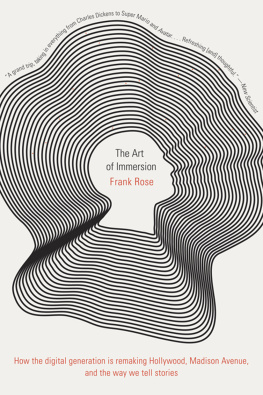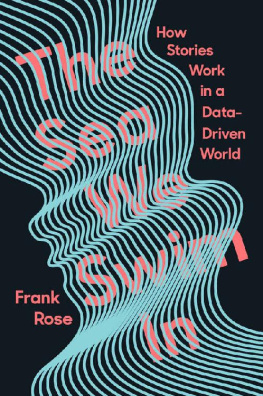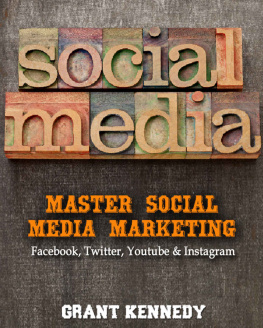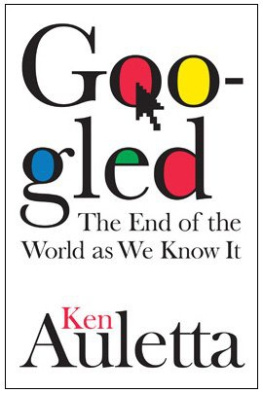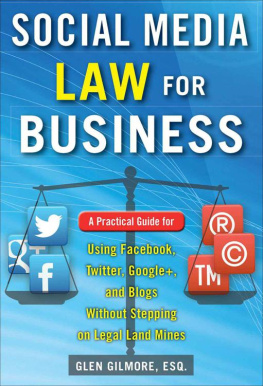H OW THE D IGITAL G ENERATION I S R EMAKING H OLLYWOOD , M ADISON A VENUE, AND THE W AY W E T ELL S TORIES
W. W. NORTON & COMPANY
I thought I should turn back; a coyotes range is large and one can trot for hours. What if his trail went on ad infinitum? What if the story had no end? Why are we so unsatisfied by tales that dont conclude, that have no gun, no knife, no corpse, that leave us hanging? What if this sentence just..!!! How much does our following words across a page engage the old neural pathways, and recapitulate the need to follow game and findthe food?
Introduction
T HIS IS A BOOK ABOUT STORYTELLING, WHICH IS TO SAY its about memory, imagination, and sharing. So perhaps I should begin by sharing a memory of my own.
I live in New York, where we recently experienced the tenth anniversary of the event known as 9/11. At 8:46 a.m. on September 11, 2001, I was in my apartment, on the fifteenth floor of a building on lower Second Avenue in Manhattan, halfway between the Midtown skyscrapers and the canyons of Wall Street. It was a spectacular fall day, the towers of Midtown glinting in the morning sun. Suddenly I saw something streaking through the skylarge, fast, low, and very, very wrong. Seconds later I heard a muffled thud. And not long after that I saw a solid line of fire trucks and ambulances screaming down Second Avenue. I raised a window, stuck my head out, and looked downtown to see where they were going. At the World Trade Center, barely two miles away, a monstrous gash in the North Tower was belching fire and smoke. I turned on the TV. Good Morning America had live, up-close helicopter footage of the burning tower. Diane Sawyer, it turned out, didnt know much more about what was happening than I did. Neither did Katie Couric on NBCs Today Show or Bryant Gumbel on The Early Show . But they were all I had.
This is how most of the world experienced 9/11through the eyes and ears and broadcasting apparatus of a small cadre of media professionals. We learned what they learned, and we shared the story they told us with people we were close toclose to physically, that is, or else on the phone with. We were consumers of news, just as we were consumers of entertainment and soda pop.
Today we live in a different world. On the tenth anniversary of 9/11, we no longer had to rely on Good Morning America , or Today , or TV of any sort. The broadcast networks and other mass media were still there, of course. The New York Times , New York magazine, The New Yorker all carried page after page of remembrances from reporters, essayists, and, in the case of The New Yorker , literary figures on the order of Jonathan Safran Foer, Colum McCann, and Zadie Smith. But they were joined by millions of other people using any number of new media channels. Jeff Jarvis, the media critic and author of What Would Google Do? , relived the events of ten years prior in a series of Twitter updates. The September 11 Memorial, which surrounds the footprints of the World Trade Centers twin towers, encouraged people to remember the anniversary using a Facebook apppart of a much larger effort to use the social-media innovations of the previous decade to let the survivors of 9/11 tell their own stories.
The memorials strategy was radical in more ways than one. Generally speaking, we create memorials in memory of things we would really rather forget. War and disaster rank high on the list: The Tomb of the Unknown Soldier in Arlington. The Civil War soldier on the courthouse lawn. The countless obelisks erected across Europe and America in memory of those who made the ultimate sacrifice in the Great War, or in the even greater war after that. We cant allow ourselves to let go of these memories, but we cant exactly live with them either. So we build a shrine to remembrance, and then we conveniently misplace the key. The memorial becomes a mausoleum for tales of sacrifice and loss.
But what if these stories were shared rather than entombed? Thirty years ago, Maya Lin took a step in that direction when she redefined the war memorial for the boomer generation. Instead of the usual heroic statues, which monumentalize an event even as they distance us from it, her Vietnam Veterans Memorial in Washington was a frank acknowledgment of lossa simple, V-shaped wall of black granite inscribed with the names of the missing and the dead. Statues were erected nearby, at the insistence of veterans groups scandalized by Lins black gash, but the wall overpowered them emotionally. Over the years it has emerged as a site that encourages private and solitary reflection: a shrine to remembrance.
As a physical space, the September 11 Memorial has a similar emotional pull. Once again, the names of the deadhere etched into bronze parapets surrounding the tower footprintsprovide a catalyst for memory. The sight and sound of a constant
cascade of water plunging 30 feet into the void is so resonant as to be almost unnerving. But the September 11 Memorial does not just provoke private memories. This time the names
come with faces and identities, all of which are shared in an online Memorial Guide.
The guide, however, is a relatively small part of the memorials Internet presence. Two years before the actual memorial opened at Ground Zero, it began to appear in virtual formfirst as a Web site where people could share stories, photos, and videos, and eventually as an iPhone app that collected many of these memories in a walking tour of Ground Zero. Each of these undertakings was the work of Local Projects, a New York design firm that specializes in co-creationthat is, collecting memories by creating a platform on which people can share their stories. How do you make a museum thats capable of appealing both to people who were there and to people who have no memory of it? says Jake Barton, Local Projects founder. Our solution was to have one group tell the story to the other group.
On the memorials Make History Web site, conceived and built by Local Projects, people are encouraged to upload their photos, their videos, and their stories. The site is searchable by topic and location, and many of the photos can be seen superimposed on a view of the location as it appears today. For the Explore 9/11 app, Local Projects used much of the same material to create a mobile tour with an augmented reality overlay: point your iPhone at a street scene near Ground Zero and you can see the same view as it appeared on September 11.
The memorial also partnered with a remarkable start-up called Broadcastr that enables its users to record their memories and tether them to a specific location. Founded by Scott Lindenbaum, an exsnowboarding champion, and Andy Hunter, whom Lindenbaum met in a Brooklyn College writing program, Broadcastr enables people to upload images and audio that it streams to users through a smartphone app. The stories that result exist in a fourth dimension, somewhere at the intersection of space and time.
With the help of Local Projects and Broadcastr, the memorial has collected memories from all over. Some were submitted by professionals like Kelly Guenther, a freelance photographer for the New York Times who grabbed her camera and raced out to the promenade overlooking the East River from Brooklyn Heights, where she captured an image of the second plane as it was about to hit the South Tower. Others were contributed by ordinary people who happened to be on the scenepeople like Erik Troelsen, a Danish engineer who was in New York on a business trip.

